So we planned to make a family trip to Barcelona last weekend… Except that everything went wrong: I couldn’t buy train tickets, and by the time I figured that, plane tickets were crazy expensive… As I didn’t have any choice and everything else was already booked, I bought them anyway. And on the day when my dad was supposed to fly to Barcelona, Riga airport had big logistic problems. Apparently they took too many flights and couldn’t manage all the planes. My dad waited for his flight for the whole afternoon, just to find out by the end of the day that his flight was cancelled and will be cancelled the following day too… So he didn’t manage to go to Barcelona! Well, considering the price I paid for the tickets to get there, my sister and I went there just the two of us.
We took the night flight on Friday and landed in Barcelona at midnight. None of us speak Spanish. And Spanish obviously don’t speak English. That’s impressive. They’re even worse at learning foreign languages than French ;-). We managed to find our tiny hotel, woke up the owner to let us in and went to bed immediately.
Day 1 Gotic District and the Cathedral
We started our journey in Barcelona on Saturday morning.
Our hotel was conveniently located near the Arc de Triomf.
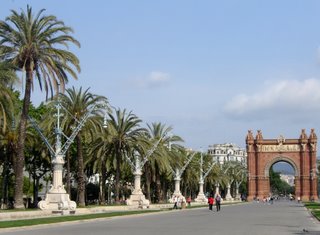 We walked past it and headed to Plaça de Catalunya. There was a HUGE queue of tourists to go on one of those tourist buses that go around the city and stop at major sight-seeing places. Another interesting thing was that shops were mostly closed in the morning and only started to open around 11am. I guess Spanish sleep late.
We walked past it and headed to Plaça de Catalunya. There was a HUGE queue of tourists to go on one of those tourist buses that go around the city and stop at major sight-seeing places. Another interesting thing was that shops were mostly closed in the morning and only started to open around 11am. I guess Spanish sleep late.We began with visiting the La Seu Cathedral in the gothic district. The Cathedral has nothing to do with cathedrals that I’ve seen before. It has a nice cloister with palm trees and a little water basin in the middle of it. It also has white geese. Exactly 13 of them, each symbolising one year in the life of the martyr Santa Eulalia, a young girl tortured to death in the 4th century by the Romans for her religion. It also had fish and turtles. I liked the cloister. But by the time we finished taking pictures of the geese, the cathedral itself was closing! Apparently they close it for lunch… so we had to go out and come back later in the afternoon to visit it. I didn’t know God was taking his time to have lunch, or maybe siesta, too…
Anyway. We wandered in the heart of the city, the historical district called Gotic District. It is a lot different from all I saw before. The coolest things ever in Barcelona turned out to be those little yards with ORANGE TREES! Oranges actually grow on the trees in the middle of the city! Excellent. They also have palm trees.
Another stereotype confirmed is that Spanish like music. They play it everywhere, in the streets, in the subway, in restaurants. And they’re good.
So after lunch we managed to visit the Cathedral, which we had to pay for. None of the cathedrals is free in Barcelona! I wonder how often they pray there if they have to pay every time just to walk in. Or they just charge tourists.
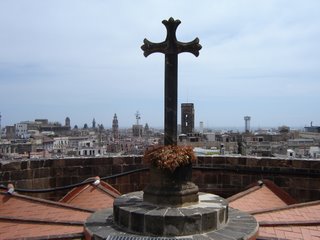 Spanish cathedrals are a lot more decorated inside than those in France. And their Maria is a lot more beautiful. However we didn’t manage to see the outside of the Cathedral, cause it was all in construction. I was so disappointed. But we did go on the roof. You have to pay to get into a cathedral in Barcelona, but the ticket includes the tour to the roofs which is pretty cool. We got a nice view of the city from up there.
Spanish cathedrals are a lot more decorated inside than those in France. And their Maria is a lot more beautiful. However we didn’t manage to see the outside of the Cathedral, cause it was all in construction. I was so disappointed. But we did go on the roof. You have to pay to get into a cathedral in Barcelona, but the ticket includes the tour to the roofs which is pretty cool. We got a nice view of the city from up there.Мы прибыли в Барселону поздно вечером в пятницу, а на следущее утро отправились исследовать город.
Наша гостиница находилась недалеко от Триумфальной Арки. Пройдя мимо неё, мы направились к площади Каталонии, где меня поразила огромная очередь перед туристическим автобусом. Даже в Париже нет таких очередей! Затем мы пришли в Готический квартал, исторический центр города, где находится старинный собор La Seu. Он совершенно непохож на соборы Франции. Он разделяется на сам собор и прилегающий к нему внутренний двор. Во дворе растут пальмы, за оградой гуляют белые гусыни, 13 штук. Рядом маленький басейн с золотыми рыбками. А по краям ниши с фигурами святых, и играет там музыка... В сам собор попасть сразу не удалось, т.к. его почему-то в обед стали закрывать. Испанский бог, наверное, тоже любит покушать!
Последовав его примеру, мы тоже пообедали и пошли бродить по старому городу. Красивый. Много где играют музыканты. Можно садится где-нибудь в тени церкви и слушать фламенко. Но больше всего мне понравились скверики, где растут апельсиновые деревья. А на них апельсины, такие красивые, цвета солнца, все так и светятся в его лучах...
После обеда мы всё-таки попали в Собор. Только платить надо за вход! Интересно, как же они ходят туда молиться, если каждый раз платить надо?! Или они туристов на глаз определяют?... Внутри испанские соборы гораздо наряднее французских, и Мария их красивая такая, а иконы все в золоте. Только вот фасад собора не удалось увидеть, он вусь в «лесах», реставрируется. Но зато на крышу поднялись, осмотрели оттуда город.
Day 1 Casa Battllo and La Pedrera
After visiting the Cathedral we headed towards the Passeig de Gracia, a huge street on which famous houses designed by Gaudi are located. As we walked out of the old city, I noticed lots of dead heads and figures of dead people sticking out of the walls randomly, sort of gargoyles maybe. Weird. Spanish picture dead people everywhere.
So we got to the Casa Battllo. It was rebuilt by Gaudi for a Spanish rich industrialist Josep Battló i Casanovas in 1904-1906. It looks fantastic. Weird and fantastic. I couldn’t believe that it was built a hundred years ago, it looks so modern!
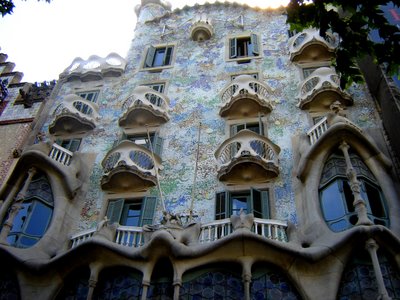
Its façade is covered with some sort of mosaic of different colours and has no straight lines. Windows, floors, the roof, the chimneys, are all wave-shaped. We entered and first visited the stairs and the roof (the main floor was for some reason closed on that day, so we had to come back on Sunday, cause we absolutely wanted to see the whole of the building). The stairs are decorated with blue tiles, their colour being more intense from up to down. In the middle, there’s a tiny elevator designed by Gaudi too. But we took the stairs to admire the “blueness” of the staircase. It definitely felt like a piece of sea inside of a house.
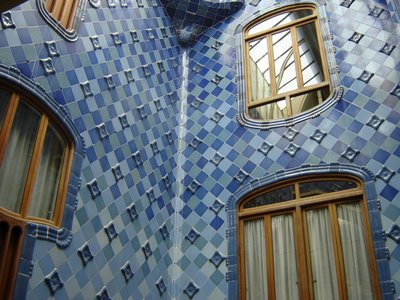
Then we went up to the attic. Wow! All white and the light, it was so amazing!
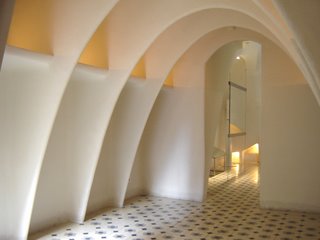 Here again, no straight lines, only curves and arcs and white light and a nice breeze coming out of the walls.
Here again, no straight lines, only curves and arcs and white light and a nice breeze coming out of the walls.  No walls in that house are hermetically closed, so that the whole building gives a feeling of freshness, which is really nice in a hot country like Spain!
No walls in that house are hermetically closed, so that the whole building gives a feeling of freshness, which is really nice in a hot country like Spain!The roof is as amazing as the rest of the house.
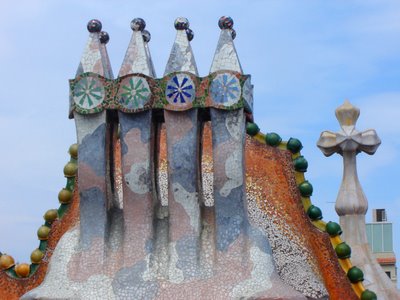
Chimneys are unique, all decorated with mosaic of different colours.
 Gaudi had a fabulous imagination…and a chance to realize his fantasies!
Gaudi had a fabulous imagination…and a chance to realize his fantasies!
Another funny thing is that Gaudi didn’t have a plan of the construction, just a few hand-made drawings which he modified constantly as construction went on. Must’ve been tough to work with him!
After Casa Battllo, we kept on walking on Passeig de Gracia, and in a few minutes were facing another, bigger house undoubtedly designed by Gaudi, too.

It turned out to be La Pedrera, the largest civil building realized by Gaudi. It was commissioned by Pedro Milà i Camps, a rich businessman who was impressed by the Casa Battló. Here again, not a single straight line is used, which we could see when we went up on the roof, cause it’s all of different levels, which makes it hard to walk on! You can only visit the attic of the building, where a Gaudi museum is currently situated. We walked through it and learned lots about the architect.
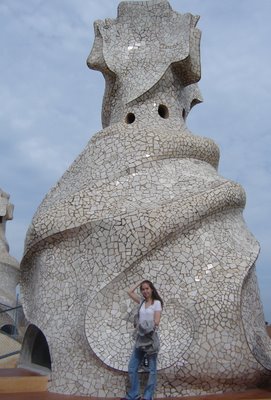 Another good thing about tourism in Barcelona is that free audio guides come together with the entrance tickets, which justifies a bit better really expensive price of the tickets to Gaudi apartments. La Pedrera is not as colourful as Casa Battllo, but not less impressive. It doesn’t have a single wall, only arcs of different shapes and lengths that carry the weigh of the roof in a genius and simple way. The roof has a number of weird-looking chimneys, even bigger than those on Casa Battllo.
Another good thing about tourism in Barcelona is that free audio guides come together with the entrance tickets, which justifies a bit better really expensive price of the tickets to Gaudi apartments. La Pedrera is not as colourful as Casa Battllo, but not less impressive. It doesn’t have a single wall, only arcs of different shapes and lengths that carry the weigh of the roof in a genius and simple way. The roof has a number of weird-looking chimneys, even bigger than those on Casa Battllo.I was impressed.
After sight-seeing we returned to the hotel and after a short break went to have dinner near Maria del Mar cathedral. A Spanish friend of my sister told us later that this was the bar district of the city. It indeed looked pretty animated at night. The dinner was good, though I wouldn’t call myself a fan of Mediterranean food. But my sister who’s planning to start learning Spanish next year started that night by learning some important stuff as “la cuenta” (the bill) and “pa amb tomaquet” (Catalan tomato bread that goes with any dish: a toast with garlic, olive oil and tomato on it, is pretty good).
